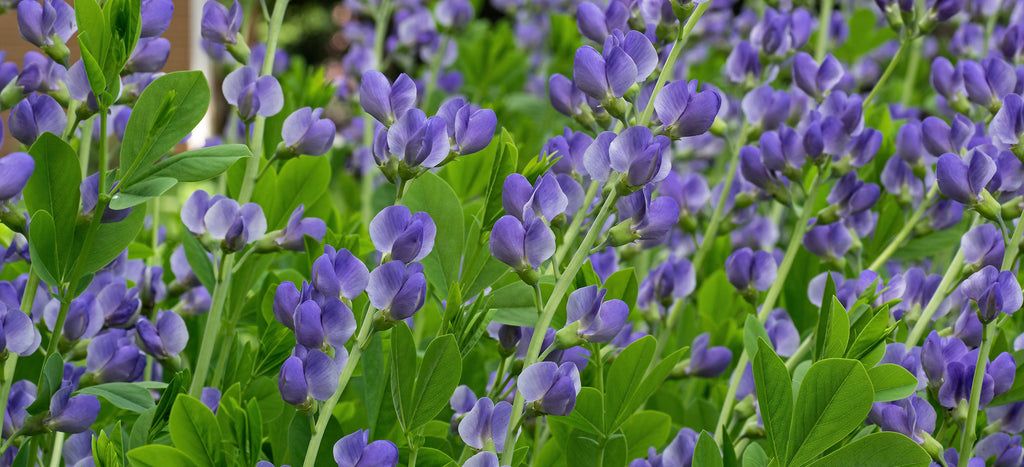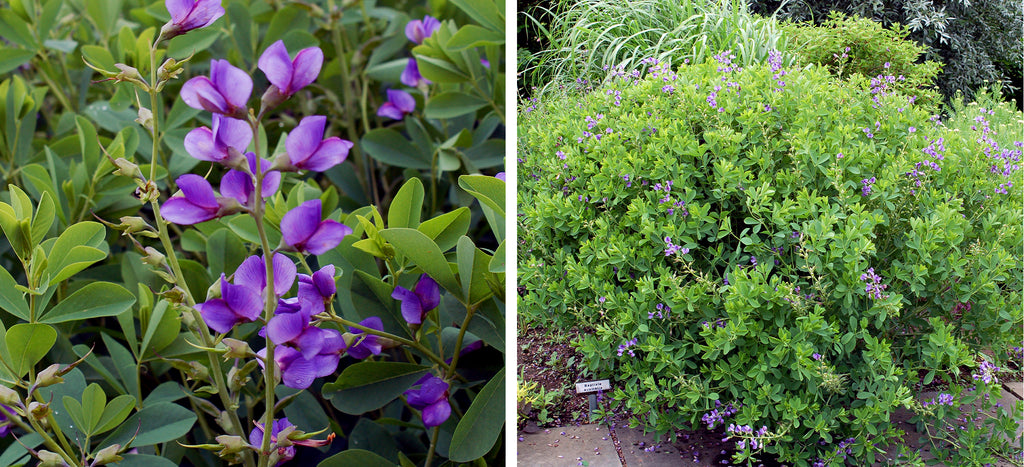False Indigo: A Native Plant with Rich Color and Richer History

True blue is rarely found in the plant world, but False Indigo (Baptisia australis) is about as close as it gets! This native flowering perennial is a member of the pea family, with pea-like flowers that bloom in shades of white, yellow, and—of course—blue. Even among designer hybrids, blue is an uncommon color to find, and many gardeners covet this rare color to add to their landscapes. Fascinatingly, the rare color of False Indigo is exactly the reason it has played a very interesting role in American history!
Historical Uses of False Indigo
While indigo-dyed blue jeans rose into fashion in the late 1800s, early American settlers—and Native Americans before them—used False Indigo as a dye to achieve blue coloring for both garments and artwork. The rare color and beauty of the plant made it of special value, though extracting the pigment from the plant was no easy task!
While we know it now as False Indigo, as opposed to true Indigo (Indigofera tinctoria), both plants didn’t exist in the same regions until traders began importing true Indigo into the United States in the mid-1700s.
As soon as Indigo quickly became a valued cash crop for its purposes as a dye, the need for False Indigo subsided. However, while no longer valuable for the textile industry, False Indigo still plays a crucial role as part of our North American ecosystem.

Environmental Benefits of False Indigo
In the wild, False Indigo is a tall, dense perennial that grows in a shrub-like form, making for excellent wildlife habitat. While the plant often doesn’t bloom until it reaches three years of age, mature plants produce an enormous amount of blue flowers that provide an excellent source of nectar and pollen for native bees and butterflies.
False Indigo is also a host plant for the larval Frosted Elfin, Wild Indigo Duskywing, Clouded Sulphur, Eastern Tailed-Blue, Orange Sulphur, and Hoary Edge butterflies. It spreads readily in a variety of prairie soils, creating a haven for these pollinators and other wildlife.
Using False Indigo in the Landscape
As a landscape plant, False Indigo is versatile and colorful. Reaching heights of 3’-5’, the plant makes an excellent pollinator-friendly backdrop for shorter native plants and behaves much like a shrub in sunny to partially sunny areas. The same compounds that give the plant its signature color also make the plant taste unpleasant to deer, which can be a significant advantage if you struggle with deer damage in your garden. Furthermore, False Indigo is very tolerant of drought—a boon for those who wish to conserve water!
Though False Indigo only flowers for 2-3 weeks of the year, the tall racemes of flowers are a delight while they last. Blooming in mid-spring, the flower spikes make excellent cut flowers and are sometimes used in place of perennial Lupine in soils where Lupines struggle to grow.

Once the flowers fade, they leave behind attractive seedpods so attractive, they make excellent additions in decorative dried flower arrangements! While the heavy seed pods are prone to weighing down and breaking the stems, those that stay standing will provide texture and interest in the fall and winter landscape. The seeds inside the pods also provide a valuable food source for birds when other sources run scarce.
While blue-toned hybrid annuals may be beautiful, pollinators prefer False Indigo any day of the week! This fabulous and historically-significant will happily populate prairie landscapes throughout the midwest and as far south as Texas, spreading its attractive tri-lobed foliage and enchanting blue flowers as it goes. False Indigo is hardy in zones 3-9, find it at your local American Beauties Native Plants® garden center!



